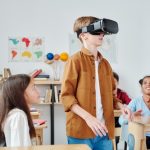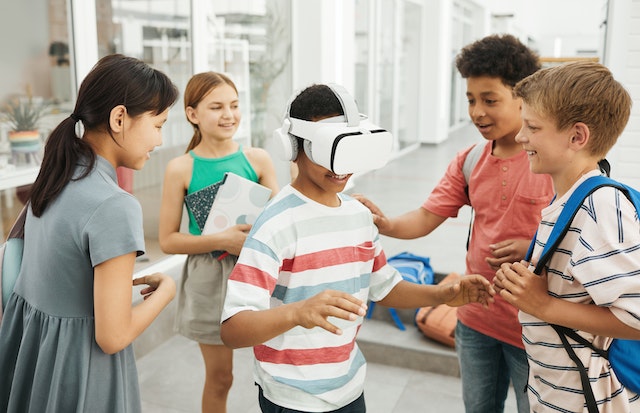
5 Ways Virtual Reality Enhances Learning
March 14, 2023
Not so long ago, Virtual Reality (VR) is something one can only see on the big screen — a concept made popular by sci-fi movies. These days, however, they are far from just being works of fiction. As technology continues to advance, the past few years have also seen VR becoming more mainstream.
Initially, VR was introduced as a powerful tool to enhance the experience of those involved in the gaming industry. Over time, however, as more people saw its potential, more industries have delved into exploring its many possibilities. Thanks to the “life-like” experiences that the technology offers, more industries have started to incorporate it into their respective processes.
The field of education is no exception. The emergence of smart VR schools in recent years showcases the many ways that VR technology can be incorporated into the learning setting. With the immersive experience it offers, VR is making learning more fun, involved, and interesting. Many institutions are even starting to recognize the many benefits VR can offer for students with disabilities. Read on as we will explore the many ways VR is making waves in education.
Practical and risk-free training
VR is known for its simulated environments. In the traditional classroom setup, students are often taught various concepts and theories, followed by practical activities to allow students to apply what they have just learned. Unfortunately, there are limitations to this in the usual school setting, particularly in the available resources to execute such training. As such, students are only likely to practice what they’ve learned a few times considering the constraints involved.

With VR however, it is more than possible for students to practice what they’ve learned in a virtual simulation as many times as they need to. VR simulations also provide students with a safe and secure setting where they can practice any unfamiliar skills without having to worry about getting injured or causing injury to others. It’s no surprise how the technology is utilized by certain industries as a useful tool for hazardous work training. This risk-free environment in a VR simulation allows students to polish their skills because they can afford to make mistakes and ultimately, learn from them.
Remote learning and accessibility
Thanks to the internet, the world these days is becoming a much smaller place. Connecting with people from across the world is more than possible. VR technology only enhances that. Through internet connectivity, VR makes it possible for students to learn no matter where they are. Students can even learn right from their homes and still experience the full classroom treatment through virtual reality. As such, VR is becoming a fantastic tool for homeschooling.
VR also promotes accessibility for learning. It doesn’t matter where you are in the world, the simulation offered by the VR technology remains the same wherever you are accessing it from. When barriers like distance are broken down, there is no stopping anybody who wants to learn. With this, VR can be used as a tool to equalize opportunities for education and learning. With its current trajectory, the technology is on the right track to transform education and introduce a less conventional approach to teaching.
Medical training and simulations
Another area that is greatly benefitting from the use of VR in education is medical training. Many hospitals and medical colleges are putting more effort into investing in VR technology for medical programs and incorporating it into their learning processes. Medical students need to hone their skills in how to handle a variety of scenarios from simple surgeries to complex operations. The immersive and interactive world of VR is the perfect platform to ensure that this is exactly what they are getting.
In traditional training settings, students cannot afford to make errors, especially when a patient’s life is on the line. With a VR simulation, however, students are free to explore every single possibility out of every scenario. They can afford to make mistakes along the way. By being able to perfect their skills through trial and error, medical students will feel more confident that by the time they graduate, they are equipped with critical practical skills to make a difference once they start interacting with real-life patients.

Virtual field trips
Perhaps one of the most popular applications of VR in the education sector, virtual tours, and field trips make it possible for learners to go to places that would otherwise be physically impossible for them. Field trips are crucial in the learning process as they reinforce what students have learned in the classroom. However, the recent pandemic has made educators realize how it is not always possible to facilitate in-person tours and trips for students.
When students are unable to step out of their homes or classrooms, VR can be used as an alternative learning tool instead. With just a VR headset, students can travel to places all over the world and even experience and immerse themselves in the cultures and traditions of these places — all without having the need to go anywhere. From doing a virtual tour of the Louvre, climbing up the Eiffel Tower, exploring the Sahara desert, or even taking a trip to space, nothing is virtually impossible with VR.
Inclusivity for students with disabilities and special needs
Students with special needs and learning disabilities will never be able to learn the conventional way. The usual medium of instruction and the use of textbooks and worksheets are never going to be as effective for them as they would be for regular students. The use of VR in special education, however, is a different story.

With VR, it is possible to work past a student’s disability and allow them to discover the joys of learning. Special needs students always learn at a different pace from their classmates in a traditional classroom setting. However, with VR technology, their learning deficiencies no longer have to hamper their education. Teachers can utilize VR technology in creating simulations that are tailored-fit to a student’s specific capacity, interests, and learning needs. When students with disabilities no longer have to be pressured to keep up with the rest of the class, they will discover a new appreciation for learning that is not possible with the conventional way of teaching.
Technology harnessed right
The many strides that VR is making in various industries and most notably, in education, is further proof that when harnessed right, technology can be a force for good. While it is true that research to quantify the many benefits of the technology in this sector is still few and far between, it is also undeniable that it has the potential to transform education in the most positive ways possible. As technology continues to evolve and more advancements are introduced in the field, it is not surprising to see how the rest of the world has shifted its gaze to VR for the possibilities it can pave the way for.